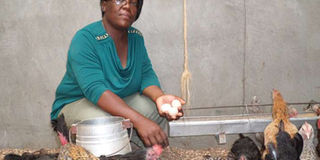Diary of a Poultry Farmer: It’s time you assess your birds’ profitability

Maximillah Muhalia attends to poultry in her farm in Nabwani Village in Vihiga County. Poultry birds' marketing depends on ones' production needs, capital and availability of market. FILE PHOTO| ELIZABETH OJINA | NATION MEDIA GROUP
What you need to know:
- For a long time, farmers like me wishing to make money from poultry believed that one could only keep so-called hybrid or exotic breeds.
- Now, with the introduction of improved indigenous breeds, there has been a rush for Kuroilers, Kuchis, Kenbros and those from Kari.
- Because of the long maturity period of up to six months, it costs more to raise an improved indigenous chicken unlike broilers that mature at six to eight weeks.
- For now, I will stick with my Kienyeji chickens, which I rear for eggs and sell later when production drops, but certainly, you have to do the mathematics.
“How do you market your chicken products?” Ann Susan Wanjiru, a regular reader of this column asked me recently.
Of course I understood her question but because I was eager to get more details, I answered it with another. “Why do you ask?”
“Finding market for my cocks and hens is a nightmare even after spending a fortune on feeding them,” she lamented.
“I tried to market a cock at Sh1,300 and a hen at Sh900 to break-even but customers complained that these prices were way too high,” she added.
“What breed do you rear?” I asked.
“Kenbro,” she replied curtly.
A few days later, I received a similar question from Winston Onyango. “I am planning to start rearing poultry although I am torn between rearing chicken for meat or eggs, what would you advise?”
Without thinking too hard, I gave this answer, “It depends on your production needs, capital and availability of market.”
Onyango was not satisfied.
“Okay. Assume there was a ready market, would you rear Kienyeji chicken or broilers?”
For a long time, farmers like me wishing to make money from poultry believed that one could only keep so-called hybrid or exotic breeds.
Now, with the introduction of improved indigenous breeds, there has been a rush for Kuroilers, Kuchis, Kenbros and those from Kari.
INDIGENOUS BIRDS' BENEFITS
In fact, my first order for 100 Kari Improved Kienyeji birds took 11 months to be delivered but I was ready to wait, partly emboldened by stories of the windfall.
I also consulted experts who told me, “Unlike exotic breeds, indigenous chickens consume less feeds, are tolerant to most diseases and have a ready market.”
“Under good management, improved indigenous breeds like Kenbros and Kuroilers can produce between 220 and 250 eggs a year,” they added.
In addition, I learnt that indigenous chicken raised under free-range systems can lay between 40 and 100 eggs per year.
I did my own research and found that by comparison, the exotic breeds such as the Leghorn can lay up to 300 eggs a year. The problem is that they are fragile, cost more to rear and require diligent husbandry.
You must be wondering about meat production. “Although broilers mature faster (six to eight weeks) and layers produce more eggs, experts concur that raising hybrid birds requires a higher level of expertise and husbandry practices. Also, one has to choose the right breed,” one animal expert intimated.
By now, I thought I had answers for Winston and Susan’s questions until I recalled a recent conversation with Dr Mugachia of GardenVet in Nairobi.
“Because of the long maturity period of up to six months, it costs more to raise an improved indigenous chicken unlike broilers that mature at six to eight weeks,” he posited.
“I hear you,” I replied, “But from my personal experience, they fetch more money in the market. I sell a cock for about Sh1,000 each,” I retorted.
CHALLENGES
Dr Mugachia was not convinced, “From our research, consumers are not willing to pay a higher premium to offset the additional cost of production for raising indigenous birds under intensive management systems.”
I agreed with him because most complain about the Sh20 that I sell my Kienyeji egg and sometimes I have had to sell at a lower price of Sh350 a crate. Currently, I am holding onto a stock of 60 crates because the offer is too low to offset production cost.
If you recall, my egg production shot up in the last two weeks. From my calculations, I need to sell an egg for at least Sh17 each to recover the cost of labour and feeds at a 50 per cent egg production rate.
I suggested to him that for improved indigenous birds, one had the option to rear them under a semi-intensive system after two months to reduce the cost of feeds.
He quipped, “Remember that under free-range system, you require one-acre for about 600 indigenous birds.” That means for 5,000 birds, the limit for making poultry venture economically viable, I would need eight acres of land.
However, I talked to farmers rearing layers and broilers and most face similar challenges: high cost of feeds, ill-defined marketing channels, low prices for meat and eggs.
For now, I will stick with my Kienyeji chickens, which I rear for eggs and sell later when production drops, but certainly, you have to do the mathematics.





